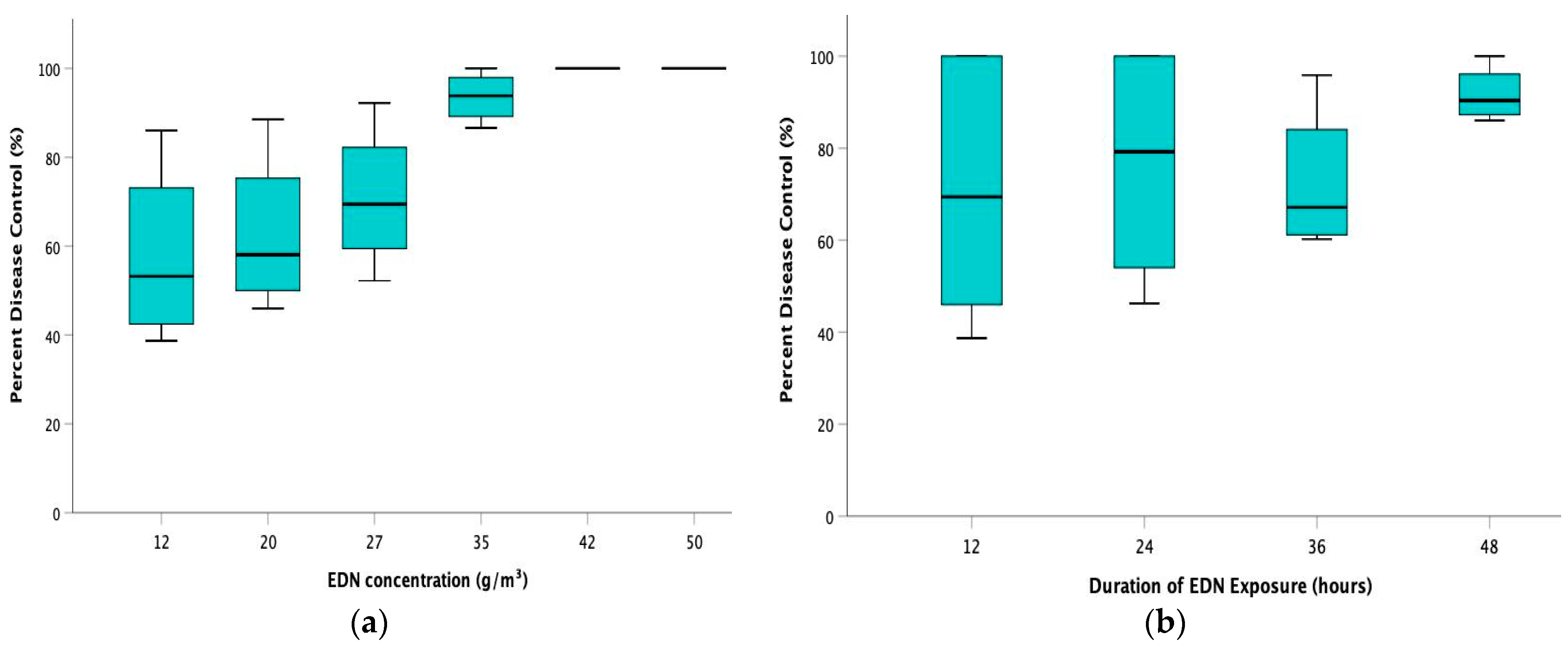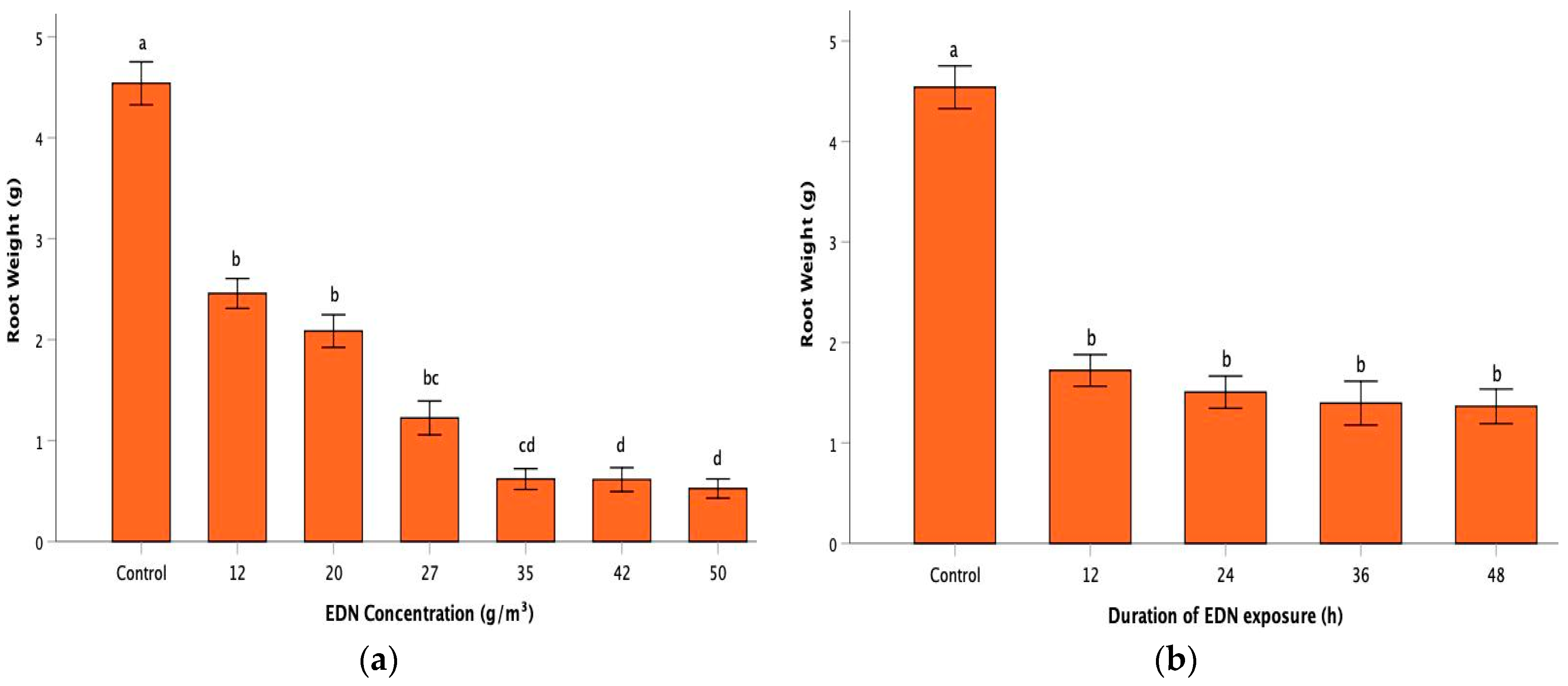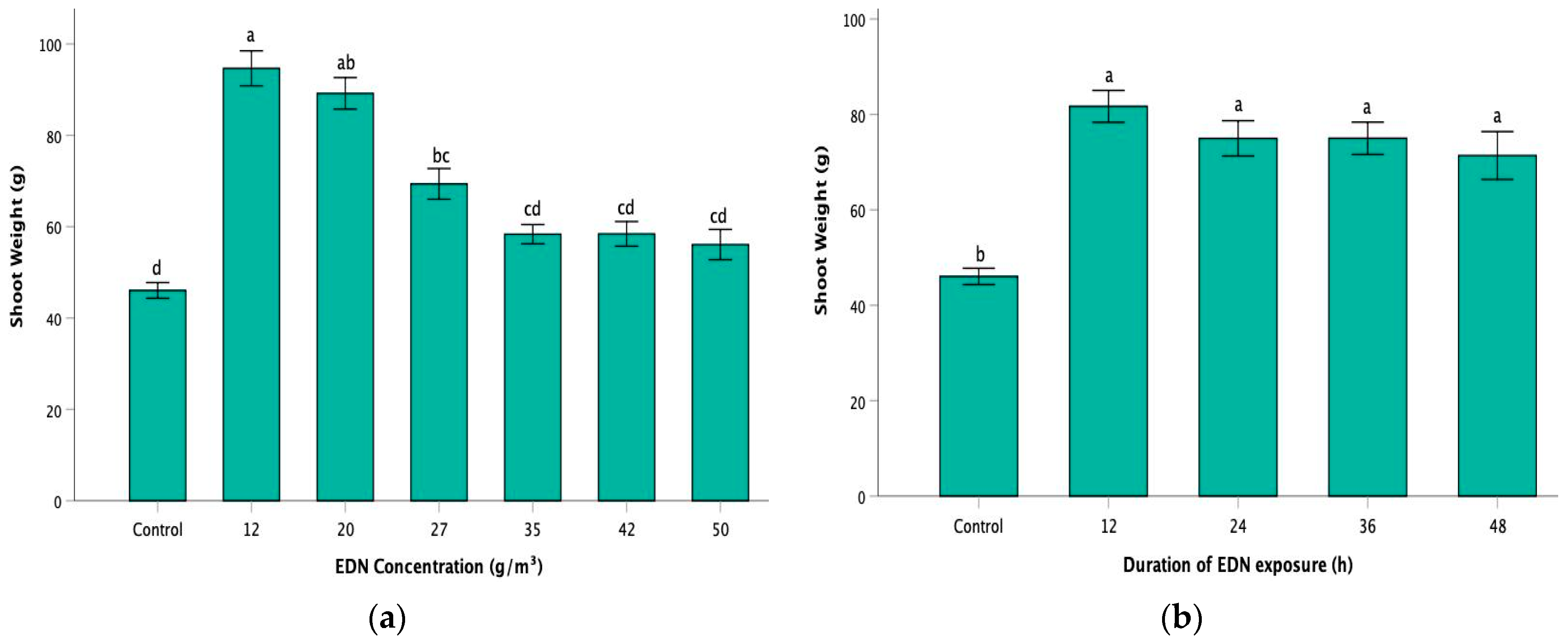Evaluation of Ethanedinitrile as a Potential Fumigant against Plasmodiophora brassicae, the Clubroot Pathogen
Abstract
:1. Introduction
2. Materials and Methods
2.1. Inoculum Preparation
2.2. Soil Preparation and Treatment
2.3. Disease Assessment
2.4. Statistical Analysis
3. Results
3.1. Effect on Disease Severity
3.2. Effect on Seedling Emergence
3.3. Effect on Plant Root Weight
3.4. Effect on Plant Shoot Weight
4. Discussion
Author Contributions
Funding
Institutional Review Board Statement
Informed Consent Statement
Data Availability Statement
Conflicts of Interest
References
- Wallenhammar, A.C. Prevalence of Plasmodiophora brassicae in a spring oilseed rape growing area in central Sweden and factors influencing soil infestation levels. Plant Pathol. 1996, 45, 710–719. [Google Scholar] [CrossRef]
- Dixon, G.R. The biology of Plasmodiophora brassicae Wor.—A review of recent advances. Acta Hortic. 2006, 706, 271–282. [Google Scholar] [CrossRef]
- Dixon, G.R. The occurrence and economic impact of Plasmodiophora brassicae and clubroot disease. J. Plant Growth Regul. 2009, 28, 194–202. [Google Scholar] [CrossRef]
- Zamani-Noor, N.; Wallenhammar, A.-C.; Kaczmarek, J.; Patar, U.R.; Zouhar, M.; Manasova, M.; Jędryczka, M. Pathotype characterization of Plasmodiophora brassicae, the cause of clubroot in central Europe and Sweden (2016–2020). Pathogens 2022, 11, 1440. [Google Scholar] [CrossRef]
- Abbasi, P.A.; Lazarovits, G. Effect of soil application of AG3 phosphonate on the severity of clubroot of bok choy and cabbage caused by Plasmodiophora brassicae. Plant Dis. 2006, 90, 1517–1522. [Google Scholar] [CrossRef] [PubMed]
- Gossen, B.D.; Adhikari, K.K.C.; Mcdonald, M.R. Effect of seeding date on development of clubroot in short-season brassica crops. Can. J. Plant Pathol. 2012, 34, 516–523. [Google Scholar] [CrossRef]
- Mitani, S.; Sugimoto, K.; Hayashi, H.; Takii, Y.; Ohshima, T.; Matsuo, N. Effects of cyazofamid against Plasmodiophora brassicae Woronin on chinese cabbage. Pest Manag. Sci. 2003, 59, 287–293. [Google Scholar] [CrossRef]
- Peng, G.; McGregor, L.; Lahlali, R.; Gossen, B.D.; Hwang, S.F.; Adhikari, K.K.; Strelkov, S.E.; McDonald, M.R. Potential biological control of clubroot on canola and crucifer vegetable crops. Plant Pathol. 2011, 60, 566–574. [Google Scholar] [CrossRef]
- Peng, G.; Lahlali, R.; Hwang, S.F.; Pageau, D.; Hynes, R.K.; McDonald, M.R.; Gossen, B.D.; Strelkov, S.E. Special Issue: Crop rotation, cultivar resistance, and fungicides/biofungicides for managing clubroot (Plasmodiophora brassicae) on canola. Can. J. Plant Pathol. 2014, 36, 99–112. [Google Scholar] [CrossRef]
- Struck, C.; Rüsch, S.; Strehlow, B. Control strategies of clubroot disease caused by Plasmodiophora brassicae. Microorganisms 2022, 10, 620. [Google Scholar] [CrossRef]
- Hwang, S.F.; Ahmed, H.U.; Strelkov, S.E.; Zhou, Q.; Gossen, B.D.; Peng, G.; Turnbull, G.D.; Fu, H. Effects of rate and application method on the efficacy of metam sodium to reduce clubroot (Plasmodiophora brassicae) of canola. Eur. J. Plant Pathol. 2018, 150, 341–349. [Google Scholar] [CrossRef]
- Hwang, S.-F.; Ahmed, H.U.; Strelkov, S.; Zhou, Q.; Gossen, B.; McDonald, M.-R.; Peng, G.; Turnbull, G.D. Suppression of clubroot by Dazomet fumigant. Can. J. Plant Sci. 2017, 98, 172–182. [Google Scholar] [CrossRef]
- Donald, C.; Porter, I. Integrated control of clubroot. J. Plant Growth Regul. 2009, 28, 289–303. [Google Scholar] [CrossRef]
- Hwang, S.F.; Ahmed, H.U.; Zhou, Q.; Strelkov, S.E.; Gossen, B.D.; Peng, G.; Turnbull, G.D. Efficacy of vapam fumigant against clubroot (Plasmodiophora brassicae) of canola. Plant Pathol. 2014, 63, 1374–1383. [Google Scholar] [CrossRef]
- Hooper, J.L.; Desmarchelier, J.M.; Ren, Y.; Allen, S.E. Toxicity of cyanogen to insects of stored grain. Pest Manag. Sci. 2003, 59, 353–357. [Google Scholar] [CrossRef]
- Wright, E.J.; Ren, Y.L.; Dowsett, H. Cyanogen: A new fumigant with potential for timber. In Proceedings of the Annual International Research Conference on Methyl Bromide Alternatives and Emissions Reductions, Orlando, FL, USA, 6–8 November 2002. [Google Scholar]
- Waterford, C.J.; Ren, Y.L.; Mattner, S.; Sarwar, M. Ethanedinitrile (C2N2)—A novel soil fumigant for insect, nematode, pathogen and weed control. In Proceedings of the 2002 Annual International Research Conference on Methyl Bromide Alternatives and Emissions Reductions, Orlando, FL, USA, 31 October–3 November 2004. [Google Scholar]
- Douda, O.; Manasova, M.; Zouhar, M.; Hnatek, J.; Stejskal, V. Field validation of the effect of soil fumigation of ethanedinitrile (EDN) on the mortality of Meloidogyne hapla and carrot yield parameters. Agronomy 2021, 11, 208. [Google Scholar] [CrossRef]
- Pranamornkith, T.; Hall, M.K.D.; Najar-Rodriguez, A.; Adlam, A.R.; Somerfield, K.G.; Page, B.B.C.; Hedderley, D.I.; Brash, D.W. Ethanedinitrile: Potential methyl bromide alternative to control Arhopalus ferus (Mulsant) in New Zealand sawn timber exports. N. Z. Plant Prot. 2014, 67, 75–79. [Google Scholar] [CrossRef]
- Ramadan, G.R.M.; Zhu, K.Y.; Abdelgaleil, S.A.M.; Shawir, M.S.; El-Bakary, A.S.; Edde, P.A.; Phillips, T.W. Ethanedinitrile as a fumigant for Lasioderma serricorne (Coleoptera: Anobiidae) and Rhyzopertha dominica (Coleoptera: Bostrichidae): Toxicity and mode of action. J. Econ. Entomol. 2020, 113, 1519–1527. [Google Scholar] [CrossRef] [PubMed]
- Ren, Y.L.; Waterford, C.J.; Matthiessen, J.N.; Mattner, S.; Gregorio, R.; Sarwar, M. First results from ethanedinitrile (C2N2) field trials in Australia. In Proceedings of the Annual International Research Conference on Methyl Bromide Alternatives and Emissions Reductions, San Diego, CA, USA, 3–6 November 2003. [Google Scholar]
- Stevens, M.C.; Freeman, J.H.; Boyd, N.S. Impact of ethanedinitrile rates and application method on nutsedge species and tomato root galling. Crop. Prot. 2019, 116, 1–6. [Google Scholar] [CrossRef]
- O’Brien, I.G.; Desmarchelier, F.J.M.; Ren, Y. Cyanogen Fumigants and Methods of Fumigation Using. Cyanogen. Patent No. 6001383, 14 December 1999. [Google Scholar]
- Matheson Tri-Gas Cyanogen Safety Data Sheet; Matheson Tri-Gas: Basking Ridge NJ, USA, 2008.
- Yu, J.; Baggio, J.S.; Boyd, N.S.; Freeman, J.H.; Peres, N.A. Evaluation of ethanedinitrile (EDN) as a preplant soil fumigant in Florida strawberry production. Pest Manag. Sci. 2020, 76, 1134–1141. [Google Scholar] [CrossRef]
- Najar-Rodriguez, A.J.; Afsar, S.; Esfandi, K.; Hall, M.K.D.; Adlam, A.R.; Wilks, C.; Noakes, E.; Richards, K. Laboratory toxicity and large-scale commercial validation of the efficacy of ethanedinitrile, a potential alternative fumigant to methyl bromide, to disinfest New Zealand Pinus radiata export logs. J. Stored Prod. Res. 2020, 88, 101671. [Google Scholar] [CrossRef]
- Ren, Y.L.; Sarwar, M.; Wright, E.J. Development of cyanogen for soil fumigation. In Proceedings of the Annual International Research Conference on Methyl Bromide Alternatives and Emissions Reductions, Orlando, FL, USA, 6–8 November 2002. [Google Scholar]
- Stevens, M.C.; Yang, R.; Freeman, J.H. Deposition and transformation of nitrogen after soil fumigation with ethanedinitrile. HortScience 2020, 55, 2023–2027. [Google Scholar] [CrossRef]
- Tewari, J.P.; Strelkov, S.E.; Orchard, D.; Hartman, M.; Lange, R.M.; Turkington, T.K. Identification of clubroot of crucifers on canola (Brassica napus) in Alberta. Can. J. Plant Pathol. 2005, 27, 143–144. [Google Scholar] [CrossRef]
- Kuginuki, Y.; Yoshikawa, H.; Hirai, M. Variation in virulence of Plasmodiophora brassicae in Japan tested with clubroot-resistant cultivars of chinese cabbage (Brassica rapa L. ssp. pekinensis). Eur. J. Plant Pathol. 1999, 105, 327–332. [Google Scholar] [CrossRef]
- Strelkov, S.E.; Tewari, J.P.; Smith-Degenhardt, E. Characterization of Plasmodiophora brassicae populations from Alberta, Canada. Can. J. Plant Pathol. 2006, 28, 467–474. [Google Scholar] [CrossRef]
- Mattner, S.W.; Gounder, R.K.; Mann, R.C.; Porter, I.J.; Matthiessen, J.N.; Ren, Y.L.; Sarwar, M. Ethanedinitrile (C2N2)—A novel soil fumigant for strawberry production. Acta Hortic. 2006, 708, 197–203. [Google Scholar] [CrossRef]
- Rosskopf, E.N.; Kokalis-Burelle, N.; Peterson, G.; Waterford, C. Preliminary Investigation of ethanedinitrile for control of weeds and nematodes important to Florida production systems. In Proceedings of the Annual International Research Conference on Methyl Bromide Alternatives and Emissions Reductions, San Diego, CA, USA, 3–6 November 2003. [Google Scholar]
- Thalavaiasundaram, S.; Ajwa, H.; Stevens, M.C. Dose-response of pests to ethanedinitrile dose-response of weed seeds, soil borne pathogens, and plant-parasitic nematodes to ethanedinitrile. Australas. Plant Pathol. 2023, 52, 133–143. [Google Scholar] [CrossRef]
- Ajwa, H.; Xuan, R.; Guerrero, J. Fate of EDN fumigant in soil. In Proceedings of the Annual International Research Conference on Methyl Bromide Alternatives and Emissions Reductions, Orlando, FL, USA, 8–10 November 2016. [Google Scholar]
- Simonne, E.H.; Mills, H.A.; Smittle, D.A. Ammonium reduces growth, fruit yield and fruit quality of watermelon. J. Plant Nutr. 1992, 15, 2727–2741. [Google Scholar] [CrossRef]
- Jenkinson, D.S.; Powlson, D.S. Residual effects of soil fumigation on soil respiration and mineralization. Soil Biol. Biochem. 1970, 2, 99–108. [Google Scholar] [CrossRef]
- Rovira, A.D. Studies on Soil Fumigation—I: Effects on ammonium, nitrate and phosphate in soil and on the growth, nutrition and yield of wheat. Soil Biol. Biochem. 1976, 8, 241–247. [Google Scholar] [CrossRef]
- Shen, S.M.; Pruden, G.; Jenkinson, D.S. Mineralization and immobilization of nitrogen in fumigated soil and the measurement of microbial biomass nitrogen. Soil Biol. Biochem. 1984, 16, 437–444. [Google Scholar] [CrossRef]




| Control 1 (n = 10) | V1 = C1 × T1 (n = 10) | V2 = C1 × T2 (n = 10) | V3 = C1 × T3 (n = 10) | V4 = C1 × T4 (n = 10) |
| Control 2 (n = 10) | V5 = C2 × T1 (n = 10) | V6 = C2 × T2 (n = 10) | V7 = C2 × T3 (n = 10) | V8 = C2 × T4 (n = 10) |
| Control 3 (n = 10) | V9 = C2 × T1 (n = 10) | V10 = C2 × T2 (n = 10) | V11 = C2 × T3 (n = 10) | V12 = C2 × T4 (n = 10) |
| Control 4 (n = 10) | V13 = C3 × T1 (n = 10) | V14 = C3 × T2 (n = 10) | V15 = C3 × T3 (n = 10) | V16 = C3 × T4 (n = 10) |
| Control 5 (n = 10) | V17 = C4 × T1 (n = 10) | V18 = C4 × T2 (n = 10) | V19 = C4 × T3 (n = 10) | V20 = C4 × T4 (n = 10) |
| Control 6 (n = 10) | V21 = C5 × T1 (n = 10) | V22 = C5 × T2 (n = 10) | V23 = C5 × T3 (n = 10) | V24 = C5 × T4 (n = 10) |
| Concentration/ Duration | Control | 12 h | 24 h | 36 h | 48 h |
|---|---|---|---|---|---|
| 12 g/m3 | 93 Aa | 57 Ab | 50 Ab | 37 Abc | 13 Ac |
| 20 g/m3 | 87 Aa | 47 Ab | 40 Ac | 33 Abc | 10 Ac |
| 27 g/m3 | 90 Ba | 43 Bb | 30 Bb | 25 Bb | 7 Bb |
| 35 g/m3 | 97 BCa | 13 BCb | 8 BCb | 4 BCb | 0 BCb |
| 42 g/m3 | 100 Ca | 0 Cb | 0 Cb | NA | NA |
| 50 g/m3 | 93 Ca | 0 Cb | 0 Cb | NA | NA |
| Concentration/ Duration | Control | 12 h | 24 h | 36 h | 48 h |
|---|---|---|---|---|---|
| 12 g/m3 | 4.61 ± 1.48 a | 2.89 ± 0.91 b | 2.51 ± 0.68 b | 2.26 ± 1.27 b | 2.18 ± 0.74 b |
| 20 g/m3 | 4.18 ± 0.54 a | 2.68 ± 0.92 b | 2.29 ± 0.49 b | 1.82 ± 1.50 b | 1.55 ± 0.61 b |
| 27 g/m3 | 4.76 ± 1.80 a | 1.61 ± 1.07 b | 1.47 ± 1.07 b | 0.88 ± 0.70 b | 0.57 ± 0.09 b |
| 35 g/m3 | 4.96 ± 2.50 a | 1.05 ± 0.64 b | 0.69 ± 0.53 b | 0.29 ± 0.25 b | 0.16 ± 0.13 b |
| 42 g/m3 | 4.61 ± 1.93 a | 0.80 ± 0.43 b | 0.32 ± 0.20 b | NA | NA |
| 50 g/m3 | 4.13 ± 1.22 a | 0.73 ± 0.15 b | 0.23 ± 0.19 c | NA | NA |
| Concentration/ Duration | Control | 12 h | 24 h | 36 h | 48 h |
|---|---|---|---|---|---|
| 12 g/m3 | 49.07 ± 8.76 b | 106.76 ± 20.21 a | 98.18 ± 24.58 a | 89.23 ± 15.60 a | 84.43 ± 31.37 a |
| 20 g/m3 | 41.11 ± 14.55 b | 101.89 ± 18.77 a | 93.32 ± 17.36 a | 83.76 ± 17.41 a | 77.74 ± 27.10 a |
| 27 g/m3 | 53.69 ± 19.58 b | 80.72 ± 21.20 a | 68.52 ± 18.32 ab | 65.51 ± 15.73 ab | 54.34 ± 7.64 ab |
| 35 g/m3 | 47.08 ± 14.16 b | 65.73 ± 11.40 a | 57.21 ± 7.23 ab | 55.76 ± 14.04 ab | 49.65 ± 6.82 ab |
| 42 g/m3 | 42.31 ± 10.69 b | 62.28 ± 15.19 a | 52.28 ± 8.37 ab | NA | NA |
| 50 g/m3 | 43.02 ± 6.4 b | 60.42 ± 11.74 a | 49.58 ± 3.02 ab | NA | NA |
Disclaimer/Publisher’s Note: The statements, opinions and data contained in all publications are solely those of the individual author(s) and contributor(s) and not of MDPI and/or the editor(s). MDPI and/or the editor(s) disclaim responsibility for any injury to people or property resulting from any ideas, methods, instructions or products referred to in the content. |
© 2023 by the authors. Licensee MDPI, Basel, Switzerland. This article is an open access article distributed under the terms and conditions of the Creative Commons Attribution (CC BY) license (https://creativecommons.org/licenses/by/4.0/).
Share and Cite
Patar, U.R.; Manasova, M.; Hnatek, J.; Wenzlova, J.; Zouhar, M. Evaluation of Ethanedinitrile as a Potential Fumigant against Plasmodiophora brassicae, the Clubroot Pathogen. Agronomy 2023, 13, 1177. https://doi.org/10.3390/agronomy13041177
Patar UR, Manasova M, Hnatek J, Wenzlova J, Zouhar M. Evaluation of Ethanedinitrile as a Potential Fumigant against Plasmodiophora brassicae, the Clubroot Pathogen. Agronomy. 2023; 13(4):1177. https://doi.org/10.3390/agronomy13041177
Chicago/Turabian StylePatar, Usha Rani, Marie Manasova, Jonas Hnatek, Jana Wenzlova, and Miloslav Zouhar. 2023. "Evaluation of Ethanedinitrile as a Potential Fumigant against Plasmodiophora brassicae, the Clubroot Pathogen" Agronomy 13, no. 4: 1177. https://doi.org/10.3390/agronomy13041177
APA StylePatar, U. R., Manasova, M., Hnatek, J., Wenzlova, J., & Zouhar, M. (2023). Evaluation of Ethanedinitrile as a Potential Fumigant against Plasmodiophora brassicae, the Clubroot Pathogen. Agronomy, 13(4), 1177. https://doi.org/10.3390/agronomy13041177








